Kung Pao Chicken is an intoxicating flavor bomb in every mouthful and destined to become a new favorite!
Kung Pao Chicken (宫保鸡丁) is easy to make at home with customizable heat, plus, it takes less time than driving to your favorite Chinese restaurant – and tastes even better! This recipe boasts juicy, undeniably tender chicken, crisp tender veggies and crunchy peanuts blanketed in an irresistible fiery, salty, savory garlic chili sauce with a kiss of sweetness. This Kung Pao Chicken recipe allows you to adjust the heat from mild to numbingly hot and to use chilies, red pepper flakes or chili sauce – whatever is easiest for you! You can also use whatever veggies you love from bell peppers and celery to water chestnuts, bok choy, carrots, mushrooms and zucchini. This Kung Pao Chicken is easy to make with a quick chicken marinade while you chop the veggies then it’s just a quick stir fry to dinner. I love to serve this Kung Pao Chicken recipe with homemade egg rolls and cream cheese wontons for a complete takeout fakeout feast.
I love making Chinese food at home and have been doing it more than ever these past few months since we’ve been on lockdown. Some of our favorites include Chicken and Broccoli, Beef and Broccoli, Mongolian Beef, Orange Chicken, Sweet and Sour Chicken, Crockpot Honey Garlic Chicken Hunan Chicken, and of course, Kung Pao Chicken!

PIN THIS RECIPE TO SAVE FOR LATER
Kung Pao Chicken Recipe
Kung Pao Chicken is one of the most popular Chinese dishes for a reason. The sauce boasts an addictive balance between sweet, salty, spicy and savory that will have you drooling. And then there’s the irresistible textures of juicy chicken, crisp veggies and crunchy peanuts – in each and every bite.
So, today I’m excited to bring you this Kung Pao Chicken recipe that will satisfy your Chinese takeout cravings – any time, and every time – in the comfort of our own home!
REASONS TO LOVE THIS RECIPE:
- QUICK and easy: This Kung Pao Chicken recipe has a long ingredient list, but I promise the recipe is EASY – most of the ingredients are just dumping and whisking to create the sauce or the marinade. So, please don’t cheat yourself out of this sensational recipe! While the chicken is “marinating,” you chop your veggies, and whisk the sauce ingredients together – that’s it – the actual cooking time is less than 15 minutes!
- Custom spice level: You can keep this Kung Pao Chicken 100% family friendly by leaving out the chili seeds or make it as spicy as you like by adding more to taste. You can even swap the chili peppers for Asian chili sauce so it’s easier to add heat to taste or add to individual servings.
- Versatile: You can use chicken breasts or chicken thighs or even swap the chicken with beef, pork or shrimp. The veggies are also completely flexible as well – perfect for using up leftover veggies!
- Nutritious: This Kung Pao Chicken recipe boasts lean chicken breasts and veggies, little sugar and is stir fried rather than fried to create a nutritious yet satisfyingly chicken dinner everyone will clamor for.
- Flavor! The Kung Pao sauce is an explosion of layers of flavor made from oyster sauce, soy sauce, chicken broth, rice wine, toasted sesame oil, Szechuan peppercorns, chili peppers and aromatic garlic and ginger.
- JUICY and so TENDER: You will LOVE the texture of the chicken – just like juicy, authentic chicken from your favorite Chinese restaurants! The marinade utilizes the easy restaurant velveting technique of adding baking powder to produce smooth, tender, melt-in-your-mouth chicken that makes you will have to taste to believe.
- Budget friendly: Feed the entire family for the fraction of dining out with the bonus of customizing the heat and veggies just how you like.
WHAT IS KUNG PAO CHICKEN?
Kung Pao Chicken is a classic dish from the Sichuan Province in China that has become a household name in the United States. Sichuan cuisine is characterized by its bold, pungent, spicy flavors from garlic, chili peppers, and Szechuan peppercorn.
In the US, Kung Pao Chicken has come to mean bite size marinated pieces of chicken breasts stir fried with peanuts, vegetables (usually onions, bell peppers and celery), and dried chili peppers in a savory, salty, glossy sauce made with chicken broth, oyster sauce, soy sauce, Chinkiang (or balsamic vinegar) and rice wine.
Why is it called kung Pao chicken?
Kung Pao Chicken is believed to be named after Ding Baozhen, a governor of Sichuan in the Qing dynasty. Kung Pao Chicken is a play on his title, Taizi Shaobao, which means palace guardian or Kung pao. The character 丁 dīng in his name can also be interpreted as “small cube,” as in small cubes of chicken. During the 1960s, the dish’s name became politically incorrect because of its association with the imperial system, so the dish was renamed “spicy chicken,” but it is still referred to as “Kung Pao Chicken” in the states.
WHAT DOES KUNG PAO CHICKEN TASTE LIKE?
In the US, Kung Pao Chicken is known for its intense, starchy, salty, savory, spicy sweet and sour sauce with a touch of sweetness. The heat comes from stir fried chili peppers and a pinch of Szechuan peppercorn. The sauce is nothing short of mesmerizing due to the layers of complex flavors.
Westernized Kung Pao chicken is less sour than authentic Kung Pao Chicken as Chinese American restaurants have altered the Chinese favorite to suite the American palate.
If you enjoy spicy foods, you will LOVE this Kung Pao Chicken recipe and if you don’t love spicy foods you will still LOVE this kung Pao Chicken recipe – simply tone down the spiciness by adding less peppers or chili paste. Now everyone can have their favorite Kung Pao Chicken they can enjoy any night of the week.
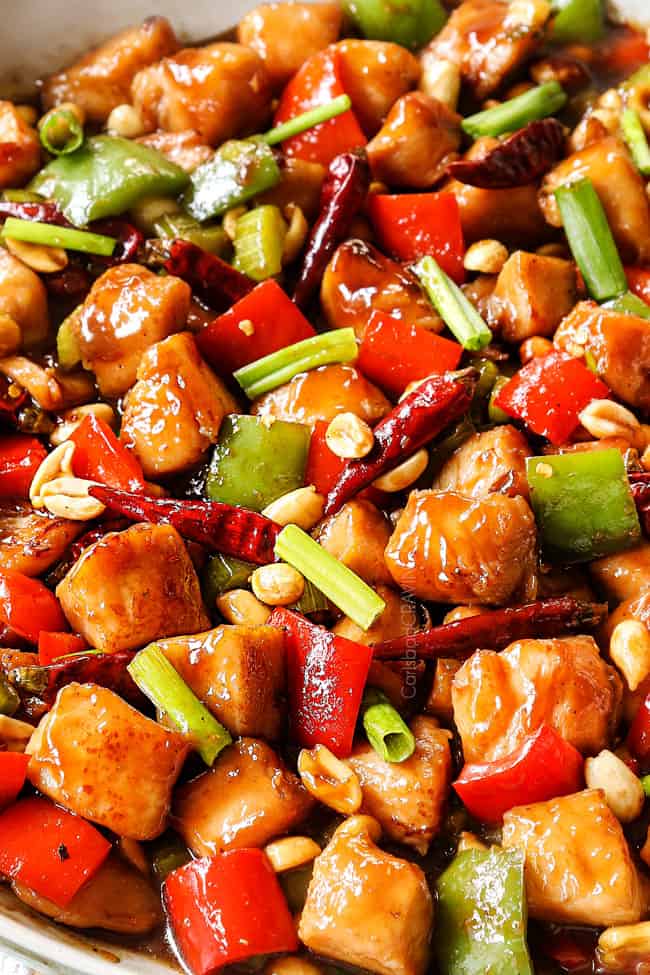
WHAT IS THE DIFFERENCE BETWEEN KUNG PAO CHICKEN and HUNAN CHICKEN?
Kung Pao Chicken is made with briefly marinated cubes of stir-fried chicken whereas Hunan Chicken is made with pan fried thinly sliced chicken lightly dusted in flour/cornstarch. Kung Pao sauce is savory and spicy like Hunan but it is sweeter and far less sour. Kung Pao Chicken is made with dried peppers verses fresh chili peppers in Hunan cuisine. Kung Pao also boasts a nutty flavor due to the peanuts. Kung Pao sauce is starchier and syrupier compared to the thinner, more oily Hunan sauce.
WHAT IS THE DIFFERENCE BETWEEN KUNG PAO CHICKEN AND GENERAL TSO’S CHICKEN?
General Tso’s Chicken is battered and deep fried whereas Kung Pao Chicken is briefly marinated then stir fried. General Tso’s Chicken is sweet and mildly spicy, far less spicy than Kung Pao Chicken, with the zing coming from a generous amount of ginger verses chili peppers. General Tso’s Chicken also does not contain any vegetables as opposed to the onions, bell peppers and celery in Kung Pao Chicken.
WHAT IS THE DIFFERENCE BETWEEN KUNG PAO CHICKEN AND SZECHUAN CHICKEN?
Both Kung Pao Chicken and Szechuan Chicken originated in the Sichuan province of China and are extremely similar. They are both characterized by their savory, hot and spicy flavors and generous use of chili peppers and garlic. They essentially use the same sauce ingredients in different proportions except Kung Pao Chicken adds Chinkiang (Chinese black vinegar) .
There are two main factors that set these Chinese favorites apart:
- 1) Kung Pao Chicken is characterized by its nutty flavor thanks to peanuts.
- 2) Szechuan Chicken is characterized by a mouth numbing, tingling sensation due to the volume of Szechuan peppercorn. The Szechuan peppercorn also add an intense peppery, citrus zing. Kung Pao Chicken only adds a small amount of Szechuan peppercorn to balance the heat of the chilies so you don’t get the same numbing, tingling sensation.
WHAT CHILI PEPPERS FOR KUNG PAO CHICKEN?
For this Kung Pao Chicken recipe, you will need DRIED, Thai chilies. Thai chilies typically can be found at an Asian market or on Amazon.
Dried Thai chilies are one-half to two inches long. These chilies range from 50,000 to 100,000 Scoville heat units which is 23 times the average heat of a jalapeño!
In order to not burn our mouths off, we stir fry the chilies whole and only add some seeds to taste. This is akin to using the flesh of the jalapenos without the seeds – you still get the flavor and some of the heat but not the numbing heat.
There are many different types of dried peppers such as arbol chilies, New Mexican chilies, ancho chiles, guajillo chiles, pasilla, etc. These are all Mexican chiles and NOT Thai chilies. Thai chiles are much smaller and therefore much spicier than the aforementioned chilies so make sure you purchase the correct chilies or see substitutions below.
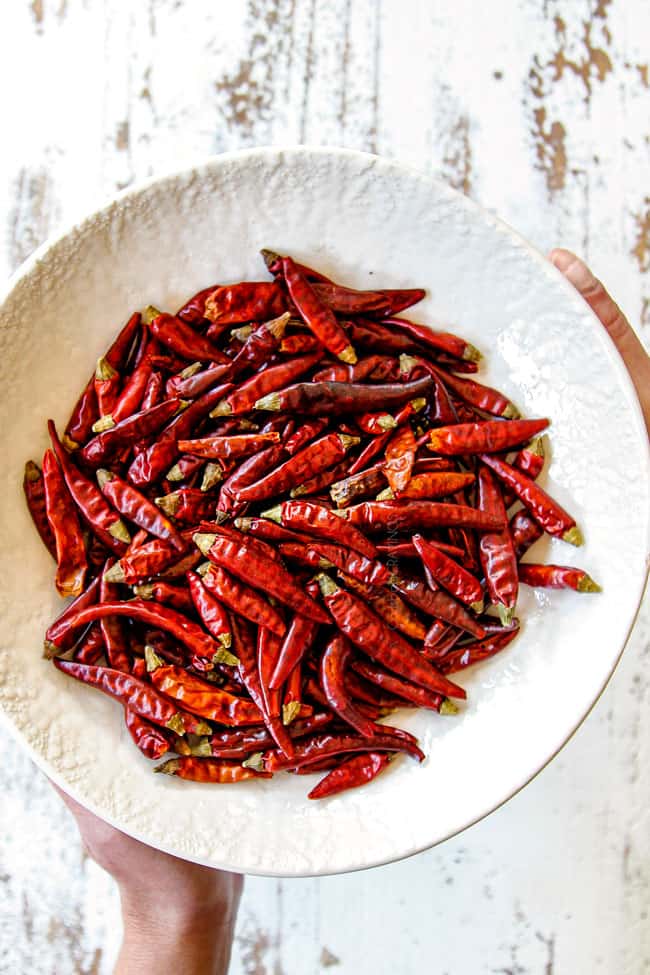
WHAT CAN I USE INSTEAD OF THAI CHILIES?
If you can’t locate Thai chiles, you can substitute them with Asian chili sauce (such as sambal oelek) which is made from a combination of chilies, including Thai chilies.
I recommend 1 tablespoon Asian chili paste plus ½ teaspoon red pepper flakes for medium spicy and 2 tablespoons Asian chili paste plus ½ teaspoon for spicier. Always start with less heat and add more to taste – because you can add heat but it’s hard to take away!
If you know you don’t like very spicy food, then I would only use 1 tablespoon Asian chili sauce and eliminate the crushed red pepper flakes. From there, you can add back a small pinch of red pepper flakes or Asian chili sauce to taste to the entire Kung Pao Chicken or to your individual servings.
HOW SPICY IS KUNG PAO CHICKEN RECIPE?
Kung Pao Chicken is meant to have a kick from chilies, ginger and garlic. That being said, it is very EASY to customize the heat of this recipe.
- MILD KUNG PAO CHICKEN: Stir fry 15 Thai chili peppers without cuttings any of them open (and of course, don’t eat the whole chilies!). This will produce mild Kung Pao Chicken that will probably be too mild and taste like it’s missing something – which is heat! You can add heat by adding chili sauce, red pepper flakes or seeds from some of the chilies.
- MODERATE KUNG PAO CHICKEN: Stir fry 15 Thai chili peppers without cuttings any of them open and seeds from 5 additional chilies, or more to taste. To add the seeds, simply cut the dried chilies open and shake the seeds out. You can also add additional seeds after you’ve tasted the finished dish if it’s not spicy enough or add seeds to individual servings.
- SPICY KUNG PAO CHICKEN: Stir fry the Kung Pao Chicken with the 15 whole Thai chilies but instead of adding seeds from 5 chilies, add more to taste. I would say 10 chilies adds a nice kick of heat but is not crazy spicy. For super spicy, use seeds from more than 10 chilies. Of course, you can always start with less and add more to taste.
***If you aren’t sure how spicy you want to make your Kung Pao Chicken, start with less chili seeds and sprinkle in more after to taste after the dish is complete. It’s easy to add heat, but it’s hard to take away!
WHAT KIND OF CHICKEN IS USED FOR KUNG PAO CHICKEN?
Chicken breasts are traditionally used in Kung Pao Chicken and will emerge incredibly tender in this recipe. That being said, you still have a few options:
- Boneless skinless chicken breasts: are leaner than chicken thighs but still emerge buttery tender from the velveting. I always use chicken breasts + velveting and I am never disappointed. It is what I have used and shown in these photos.
- Boneless skinless chicken thighs: are dark meat and therefore inherently juicier and hard to overcook or dry out or overcook. Thighs are the best option if you want to skip the velveting but I recommend velveting either way because it infuses the chicken with flavor.
- Can I use different Protein? Looking beyond poultry, try out cubed tofu, pork or shrimp. If using shrimp, add it at the end of cooking because shrimp will get rubbery if overcooked.
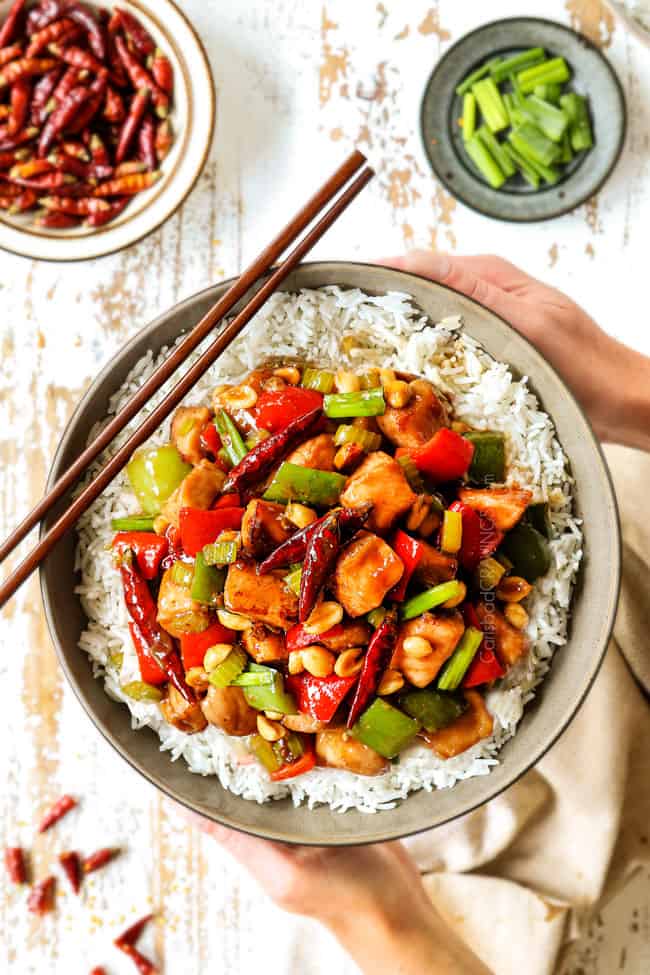
HOW DO YOU MAKE KUNG PAO CHICKEN EXTRA TENDER?
This Kung Pao Chicken is not only crazy delicious but the chicken is wonderful silky and juicy due to a simple process called velveting. I first introduced you to velveting in my chicken stir fry recipe, and can attest it makes ALL THE difference. It is how Chinese restaurants attain such smooth, tender chicken – and now you can get the same results at home!
There are a few different velveting techniques, but I opt for the easiest one using baking soda; and don’t worry, you can taste the textural difference but not the baking soda! Essentially, the chicken is marinated in a combination of baking soda, soy sauce, rice wine, sesame oil, and cornstarch. Here’s how it works:
- baking soda: tenderizes the chicken by breaking down the chicken fibers so the chicken emerges softer on the inside like “velvet” – hence the name.
- soy sauce: the salt in the soy sauce also helps break down the proteins for a more tender texture and infuses the chicken with flavor.
- rice wine: is an acidic ingredient that breaks down lean muscle fibers on the surface of the protein.
- cornstarch: acts as a binder and helps our soy sauce bind to the chicken for more flavorful chicken. Cornstarch also provides a light coating that helps protect the chicken from drying out while cooking.
This easy velveting technique can be used in all your favorite Chinese Chicken recipes – even the ones with breading; instead, skip the breading and add whatever seasonings were in the breading to the velveting mixture. This allows you to enjoy the intoxicating sauces without the hassle of breading. Try it on my Cashew Chicken Stir Fry, Hoisin Ginger Chicken, Honey Lemon Chicken and Honey Coconut Chicken.
WHAT IS IN KUNG PAO Chicken SAUCE?
The BEST Kung Pao Chicken starts with the best sauce! The ingredient list is a bit lengthy, but remember, we are just adding the ingredients and whisking to create the sauce in minutes. Here’s what you’ll need:
- Oyster sauce: is a necessity in this Kung Pao Chicken recipe and all Chinese stir fry recipes. It adds that extra punch of authentic, umami flavor. Oyster sauce is a thick, brown sauce with a balance between sweet and salty with an earthy undertone, due to the oyster extracts. You can find oyster sauce in the Asian aisle of any supermarket for only a few dollars. Please use QUALITY oyster sauce such as Lee Kum Kee or Kikkoman. You truly can taste the difference and will be sorely disappointed with less quality brands.
- Soy sauce: use reduced sodium soy sauce so we can control the salt level.
- Chicken broth: use low sodium chicken broth or your dish will be too salty. You can also use vegetable broth but chicken broth is more flavorful. Pro Tip: You can freeze unused chicken broth in desired quantities in plastic bags so it doesn’t go to waste.
- Chinese black vinegar: (often known in its most popular form, Chinkiang or Zhenjiang vinegar), is dark, complex and fruity with umami rich undertones. It is often compared to balsamic although it is less sweet, and ultimately so unique that I hesitate to even attempt to describe it. You should be able to find Chinese Black Vinegar at Asian specialty markets or you may substitute with half balsamic vinegar and half rice vinegar.
- Rice wine: adds a sweetness and depth of flavor. I use “Kikkoman Aji-Mirin: Sweet Cooking Rice Seasoning” which is commonly found in the Asian section of most grocery stores or you can Amazon it. I highly suggest you google image before you head off to the grocery store so you know exactly what you are looking for. The best substitute for rice wine is pale dry sherry. Do NOT substitute rice wine with rice vinegar, they are NOT the same. Rice vinegar will add an acidic flavor without the sweetness.
- Brown sugar: use light brown sugar. It adds sweetness to balance the oyster sauce, soy, rice wine and heat. You can more or less depending on personal preferences.
- Szechuan peppercorn: I use ground peppercorn powder for ease or you can purchase whole peppercorns and toast and grind them yourself. Szechuan peppercorn (“peppercorn” is the correct plural form), taste perfumy, complex, and peppery with a citrus zing and pine, lavender notes. They remind me of a complex cross between pepper, cardamom, ginger, clove and lemon. When they are used in higher volumes, they create tangible mouth-numbing sensation, but we aren’t going for that in this recipe.
- Sesame oil: adds a wonderful subtle nutty flavor. You skip it if you don’t have it on hand.
- cornstarch: helps thicken the sauce to a glossy, luscious consistency so nice it’s not watery.
- Aromatics: ginger, onions and garlic (added with the stir fry) add warm spicy, almost peppery taste. These aromatics awaken and elevate the entire recipe. If you’re looking to save time and skip some chopping, you can substitute the fresh onions, garlic and ginger with powders. The typical rule of thumb is 3:1, so one part dried to three parts fresh.
- Ginger pro tip: I like to freeze ginger so it’s always at my fingertips. To freeze ginger: grate it, spread it by the teaspoon or tablespoon on parchment paper and flash freeze until solid, about 1 hour. Transfer to an airtight container or plastic bag for up to 6 months. You can add frozen ginger directly to your stir fry.
DO I HAVE TO USE SZECHUAN PEPPERCORN IN THIS RECIPE?
Although Kung Pao Chicken doesn’t require as much Szechuan peppercorn as Szechuan Chicken and Szechuan Beef, I highly recommend using it in this recipe. It really adds a complex layer of flavor that amps up the authentic flavor. Plus, now you can use it in the other Szechuan recipes!
WHERE TO BUY SZECHUAN PEPPERCORN
Szechuan peppercorn can be found on Amazon (my fav!) at most Asian markets (call first) spice stores, or sometimes specialty stores like Whole Foods and Sprouts. I prefer Szechuan peppercorn powder because it is easy to use and save you a tedious step.
The most important thing to be aware of is that Szechuan Peppercorn can be sold under different names: dried peppercorn, dried prickly ash, dehydrated prickly ash, Indonesian lemon pepper, flower pepper, or hua jiao.
SZECHUAN PEPPERCORN SUBSTITUTIONS
Szechuan peppercorn adds peppery heat and complex citrus notes that is hard to replicate. That being said, you can use a Szechuan peppercorn substitute if don’t have access to it. There are many substitutes such as grains of paradise, Tellicherry peppercorns and Tasmanian pepper but the most accessible is freshly ground pepper and coriander.
- Pepper + Coriander: The pepper brings the peppery heat and the coriander brings the fresh, pungent citrus flavor. Use both freshy ground pepper and freshly ground coriander for best results when possible.
- Pepper: The last option would be to use freshly ground black pepper to provide the peppery heat but it would be lacking in the unique, complex, flavor notes.
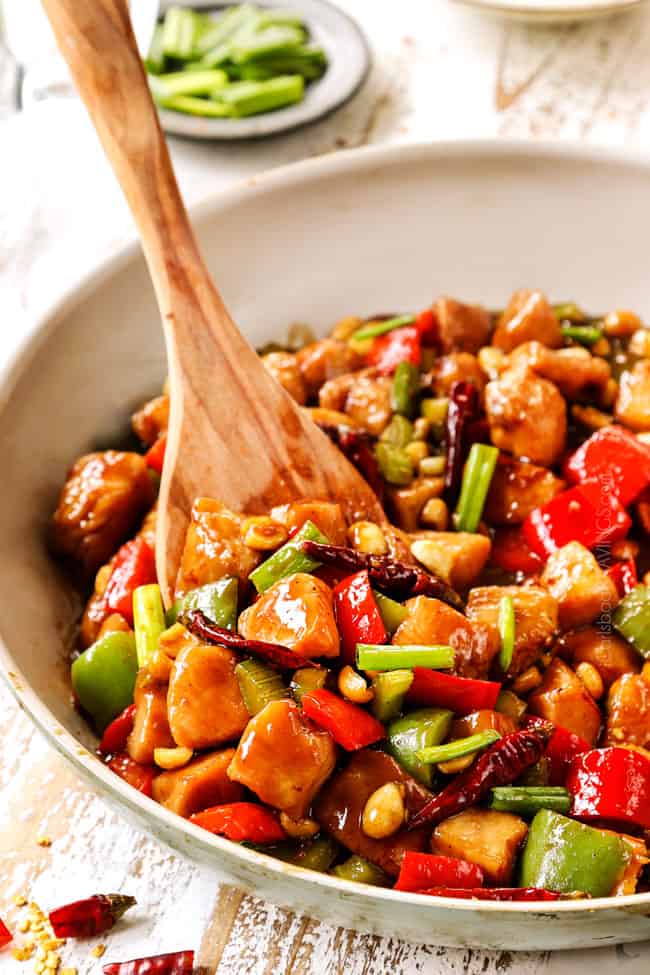
IS KUNG PAO CHICKEN RECIPE GLUTEN FREE?
As written, this Kung Pao Chicken recipe is not gluten free. To make it gluten free, use gluten free soy sauce or tamari. Chines black vinegar also can contain traces of vinegar so substitute with half rice vinegar, half balsamic vinegar. You will also want to double check that your oyster sauce is gluten free.
WHAT IF I’M ALLERGIC TO SHELLFISH?
If you’re allergic to shellfish, use LEE KUM KEE Vegetarian Stir-Fry Sauce instead of oyster sauce.
HOW DO I THICKEN KUNG PAO SAUCE?
The cornstarch in the Kung Pao sauce will thicken the sauce as it simmers with the vegetables. If you still would like a thicker sauce, then just keep simmering until it reaches desired consistency. For an even thicker sauce, make a slurry by whisking 1 teaspoon cornstarch in 2 tablespoons chicken broth then adding to the simmering sauce.
HOW DO I THIN KUNG PAO SAUCE?
Your sauce will thicken more the longer it is simmers. If it simmers to the point of too thick, don’t worry! It is easy to thin by whisking in additional chicken broth.
HOW DO I STORE THE SAUCE?
Kung Pao sauce can be made ahead of time and stored in an airtight container or mason jar in the refrigerator for up to two weeks. Shake it up or whisk it to recombine before using.
HOW DO I CUSTOMIZE KUNG PAO SAUCE?
This Kung Pao sauce can easily be adjusted to suite your personal preferences. Just keep a note of your adjustments then whip out the perfect sauce every time. Here’s how:
- for more fruity tanginess, add more Chinese black vinegar
- for more sweetness, add additional brown sugar
- spice it up with additional chili seeds, red pepper flakes or Asian chili paste
- add salt with additional soy sauce
- amp up the garlic and/or ginger for a stronger punch of flavor
WHAT VEGETABLES DO YOU USE IN KUNG PAO CHICKEN?
Kung Pao Chicken is traditionally made with onions, bell peppers and sometimes celery so the silky chicken and sauce can really shine. That being said, feel free to add additional vegetables or swap the veggies based on what’s in your fridge, your favorites, what’s in season or what’s on sale.
Here are some great vegetables to try:
- Broccoli
- Carrots
- Mushrooms
- Snow Peas
- Snap Peas
- Zucchini
- Celery
- Asparagus
- Baby corn
- Edamame
- Bean sprouts
- Cabbage (green or red)
- Spinach
- Bok choy
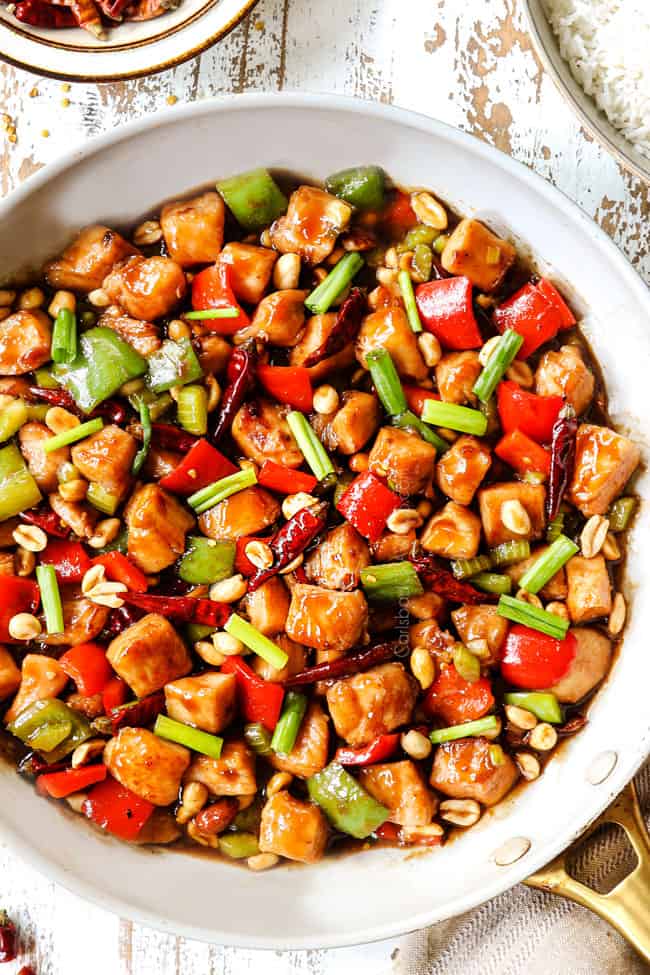
HOW DO I CHOP VEGETABLES FOR KUNG PAO CHICKEN?
Texture is key in any stir fry so it is important to keep that in mind when chopping your veggies – you don’t want some veggies to be crunchy and some to be mushy! There are some vegetables that take longer to cook such as broccoli and carrots and some take less time to cook such as zucchini and bell peppers.
For this recipe, chop your bell peppers into 1-inch squares and dice your celery by slicing the stalks in half and then thinly slicing.
If you choose to use other vegetables, keep in mind longer cooking vegetables need to be chopped smaller/thinner, and the shorter cooking vegetables larger. For example, THINLY slice the carrots, and thickly slice zucchini so they cook in the same amount of time.
This technique will take care of most veggies, but there are some that cook in extremely short time such as snow peas, cabbage and spinach, which should always be added at the very end of cooking
KUNG PAO CHICKEN VARIATIONS
Authentic Kung Pao Chicken typically doesn’t include more than protein and veggies, but that doesn’t mean you can’t mix up yours! Here are some add-in ideas:
- Nuts: swap the peanuts for cashews to add a buttery, nutty crunch.
- Water chestnuts: also add a tantalizing crunch. Water chestnuts are easy to find in a can so you can keep them stocked and ready to go.
- Canned bamboo Shoots: should be easy to find at every grocery store. They add a crunchy, meaty texture.
- Sesame seeds: add the nutty sesame flavor. Take care to use toasted sesame seeds or toast them yourself.
- Pineapple: always a welcome addition – just think teriyaki chicken and pineapple.
- Mango: one of my favorite fruits to add to EVERYTHING. If you’re intimidated by choosing or cutting mangos, check out this post here.
- Mandarin oranges: use canned or fresh. Fresh hold together better but canned or super convenient.
HOW DO YOU MAKE KUNG PAO CHICKEN?
This Kung Pao Chicken recipe requires a few steps, but they are all easy and important to create the world-famous deeply flavorful Chinese Chicken. Here’s the breakdown:
STEP 1: MARINATE CHICKEN (“Velveting”)
- Marinating the chicken ensures juicy, flavorful, silky chicken. The marinating/velveting process is simple – add cornstarch, baking soda, sesame oil, soy sauce and rice wine to a large freezer bag or bowl; whisk to combine.
- Add chicken and turn until evenly coated. Let sit at room temperature.
- TIP: Use the marinating time to prep your bell peppers, aromatics and to whisk the sauce together.
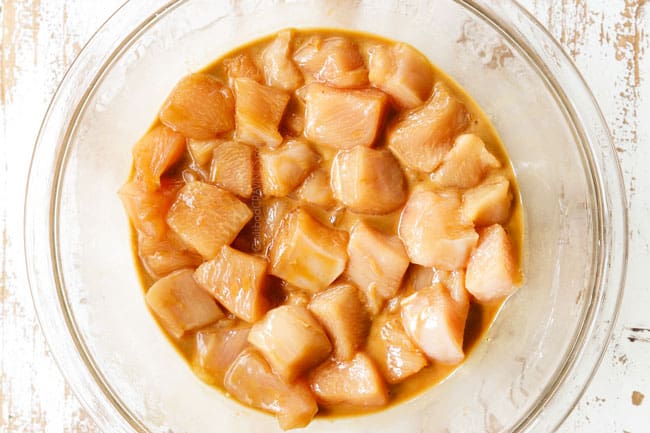
STEP 2: COOK CHICKEN
- Heat 1 tablespoon vegetable or peanut oil in a large nonstick skillet over medium-high heat. Make sure to use a neutral oil so the chicken isn’t tainted. Once very hot, add chicken in a single layer and cook until golden then stir and cook chicken just until opaque. Transfer to a plate.
- TIP: The chicken shouldn’t be cooked all the way through because it will finish cooking in the stir fry sauce. Don’t overcook it or it won’t be as tender.
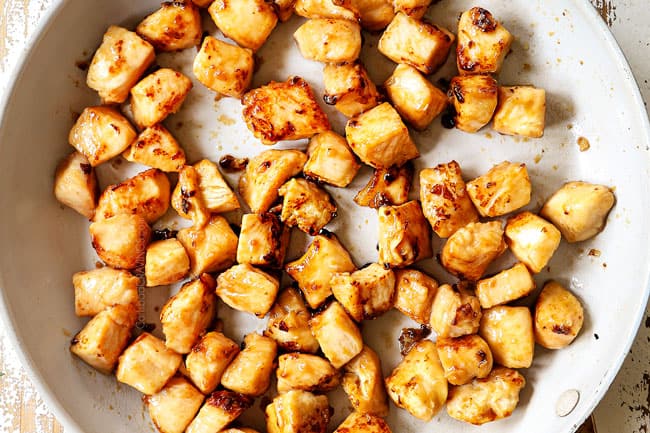
STEP 3: STIR FRY VEGGIES
- Heat 1 ½ tablespoons oil over medium-high heat. Once very hot, add peanuts, white parts of onions, celery, bell peppers, ginger, garlic, dried chilies and chili seeds and stir fry one minute.
- TIP: After you remove the chicken, don’t wipe out the skillet; we want all those brown bits leftover from the chicken to flavor the veggies.
- TIP: Set a timer and DON’T over-cook the veggies because the bell peppers will continue to cook in the sauce – we want crisp tender veggies, not tender crisp. Also, you don’t want to burn the garlic.

STEP 4: COMBINE & THICKEN SAUCE
- Return the chicken to the skillet. Whisk the sauce to recombine then add to the skillet.
- Cook, stirring constantly, until the sauce is thickened and chicken is cooked through, about 1-2 minutes. Stir in in green parts of green onions.
- TIP: The consistency of the sauce is up to you – for thinner sauce, simmer for less time, for thicker sauce, simmer for more time. Just make sure the chicken is cooked through when you’re finished.
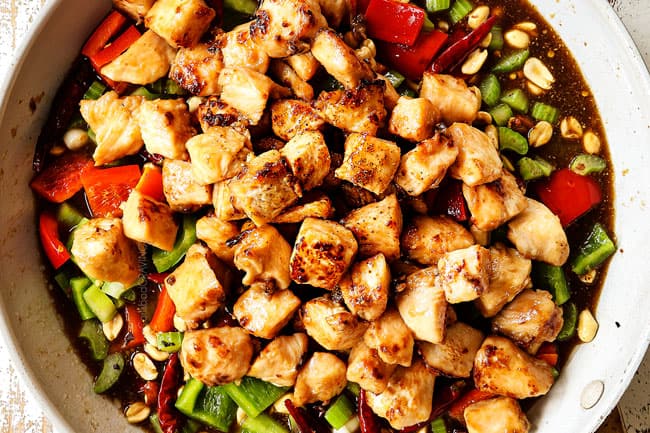
TIPS AND TRICKS FOR KUNG PAO CHICKEN RECIPE
This Kung Pao Chicken recipe is pretty straightforward, but here are some tips and tricks to make it a sizzling success:
- Customize heat. See my detailed section about customizing heat and substituting chili sauce for chili peppers. If you feel like the Kung Pao Chicken is missing something – it is probably heat!
- Don’t use salted peanuts. Only use UNSALTED peanuts or your Kung Pao chicken will be far too salty. Also, purchase roasted, unsalted peanuts for an added dimension of flavor, otherwise, toast the peanuts yourself in a dry skillet over medium heat until golden in some pots.
- Chop chicken into large pieces. Go for about 1 ½ inch pieces of chicken. Larger pieces of chicken are harder to overcook and dry out and will taste far juicier.
- How to chop vegetables. The most important key to making a good stir-fry is cutting each ingredient to a uniform size as specified in the recipe. As detailed earlier in the post, chop the bell peppers large and the celery small.
- Customize veggies. You can substitute the bell peppers for your favorite veggies. Cut long cooking vegetables small and short cooking vegetables larger.
- Don’t skip the marinade/velveting. This ensures that the chicken is tender just like Chinese restaurants. If you need to skip it, then go with chicken thighs instead of chicken breasts.
- Don’t marinate chicken for too long. The bite-size pieces of chicken should not be marinated longer than 30 minutes or else they can become mushy.
- Prep veggies and sauce first. While your chicken is marinating, chop all your veggies, aromatics and prep your sauce. You want everything ready before you start cooking because the actually stir fry portion just takes a few minutes. If you have to stop to make your sauce while your bell peppers are still in the pan, they can end up soft and even worse – mushy.
- Cook chicken first. Don’t cook the chicken and veggies together because we want to brown the chicken (color + flavor) which can’t happen with all the veggies in the pan. The chicken will also leave behind yummy brown bits which will give the veggies flavor.
- Hot but not too hot skillet. Your pan should be hot enough so that the chicken and veggies sizzle when they touch the pan and continue to sizzle but the pan shouldn’t be so hot that it smokes excessively once you add the oil. If the pan is smoking hot, remove it from heat, let it cool slightly then return to heat. To determine if the pan is hot enough, flick a few droplets of water onto the skillet or wok. The beads of water should evaporate within 2 seconds.
- Don’t overcook chicken. For the juiciest chicken, don’t overcook! Brown it in the skillet but let it finish cooking in the sauce.
- Don’t overcook bell peppers. I suggest setting the timer for 60 seconds so you don’t overcook the bell peppers. It is better to under-cook them when stir frying then allow them to reach desired-crisp tenderness once you add the sauce.
- Add sauce to the sides of the pan. Pour the sauce around and down the sides of the pan instead of directly into the center. This will prevent the pan from cooling down too much.
HOW DO I MAKE CRISPY KUNG PAO CHICKEN?
This Kung Pao Chicken is healthier because it is stir fried verses fried and you still get the crunch from the peanuts. If you would still like crispy chicken, you will need to fry the chicken:
- After marinating, toss the chicken in ¼ cup self-rising flour and ¼ cup cornstarch.
- Fill the bottom of a heavy bottom pan with 2 inches of vegetable oil or other high smoking point oil.
- Heat oil to 375 F degrees until very hot and smoking – the oil should sizzle if you flick water on it.
- Add chicken in a single layer using tongs.
- Fry until deeply golden and chicken registers 165 degrees F.
- Remove to a cooling rack set over paper towels to drain.
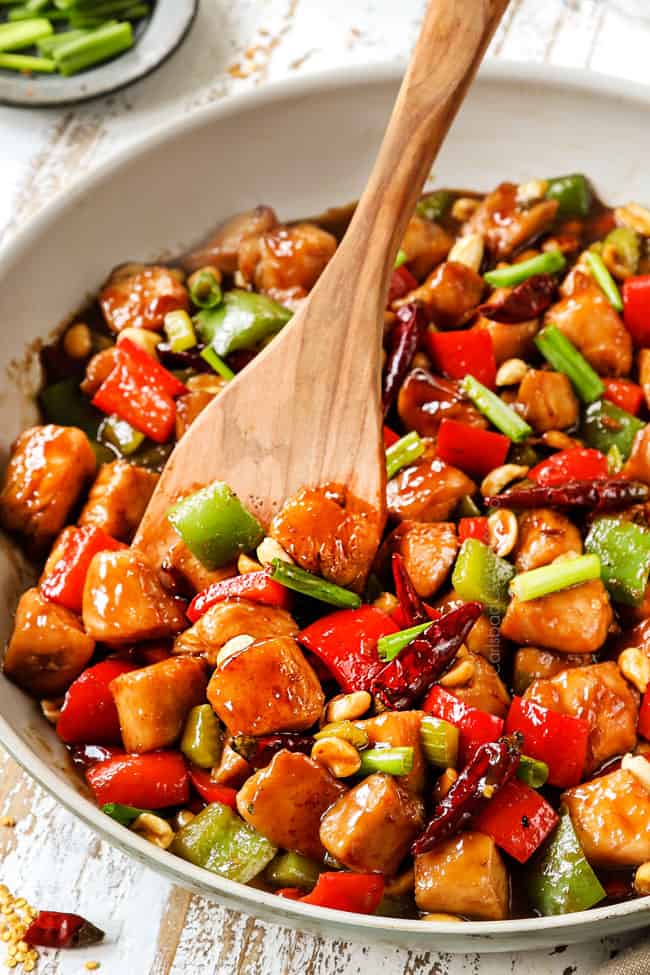
WHAT SHOULD I SERVE WITH KUNG PAO CHICKEN?
Kung Pao Chicken is intensely flavorful so it pairs well with neutral sides such as:
- Rice. I like jasmine rice or brown rice but any rice will work. Just pop the rice in your rice cooker for a hand’s off, easy side. You can also use microwave rice pouches if you’re making a serving for one or meal prep.
- Low carb. Cauliflower rice, quinoa, broccoli rice or a blend of brown rice and any of the aforementioned options. You can also use low carb noodles such as zoodles or spaghetti squash.
- Noodles. Ramen, soba noodles, rice noodles or even linguine are a fun way to mix things up!
- Appetizers: For a complete Asian feast, pair Kung Pao Chicken with Potstickers, Pineapple Cream Cheese Wontons, Crab Rangoons, and/or Egg Rolls
- Salad: some of our favorite Asian inspired salads include Crunchy Asian Salad, Chinese Salad, and Asian Pineapple Salad.
- Soups: Asian soups make a fantastic starter such as Wonton Soup, Egg Drop Soup or Miso Soup.
HOW TO PREP AHEAD
Kung Pao Chicken has a few steps, but you can prep almost everything ahead of time for a speedy dinner. Here’s how:
- Chop chicken. Chop chicken into large bite size pieces any time before marinating then store in an airtight container in the refrigerator.
- Make sauce. Whisk the ingredients together up to 24 hours in advance and store, covered in the refrigerator. Let the sauce sit at room temperature for 30 minutes or so before using.
- Chop veggies. You can chop your garlic, grate your ginger and chop your celery and bell peppers 24 hours in advance and store in separate air tight containers in the refrigerator.
- Cook! Within the next 24 hours, proceed with the recipe starting with marinating the chicken for 20-30 minutes.
HOW TO STORE and REHEAT
Kung Pao Chicken reheats very well if not initially overcooked.
- How to store: Store leftovers in an airtight container in the refrigerator for up to 5 days.
- How to reheat in microwave: Transfer small portions to a microwave safe dish, heat for one minute, stir then continue to heat at 30 second intervals.
- How to reheat on the stove: For larger portions, rewarm gently in a large skillet, stirring often. You may need to add a splash of water (better yet chicken broth if you have it) to thin the sauce as needed.
CAN YOU FREEZE KUNG PAO CHICKEN?
Yes, Kung Pao Chicken freezes very well, except for the bell peppers. If using bell peppers, you may want to pick them out or they will become mushy when thawed. Also, take care not to overcook the chicken or it won’t be as tender when reheated.
- Let Kung Pao Chicken cool completely in the refrigerator.
- Transfer to an airtight container. If using a freezer bag, squeeze out any excess air to prevent freezer burn.
- Label and freeze for up to 3 months.
- When ready to eat, let the chicken thaw overnight in the refrigerator.
- Reheat in the microwave for 60 seconds then at 30 second intervals or gently on the stove.
IS KUNG PAO CHICKEN HEALTHY?
This Kung Pao Chicken recipe is healthier than other fried Chinese chicken recipes. The chicken is a lean protein which means it doesn’t have very much fat which can help you maintain a healthy lifestyle and even lose weight all while helping to sustain your muscles. Chicken is also full of calcium and phosphorous which helps strengthen your bones and reduce the risk of arthritis.
The recipe veggies are also cholesterol free and provide vitamins and minerals. The veggies also retain more nutrients when stir fried verses being boiled. Just some of the nutrients in fresh veggies include vitamins A & C, potassium, folate and dietary fiber. Diets rich in potassium may help to maintain healthy blood pressure and dietary fiber helps reduce blood cholesterol levels and may lower risk of heart disease.
To make your Kung Pao Chicken even healthier:
- Add more veggies or substitute some of the chicken with more vegetables. The more vegetables, the better!
- Use chicken breasts instead of chicken thighs.
- Serve the Kung Pao Chicken with cauliflower rice, quinoa, or zucchini noodles instead of rice.
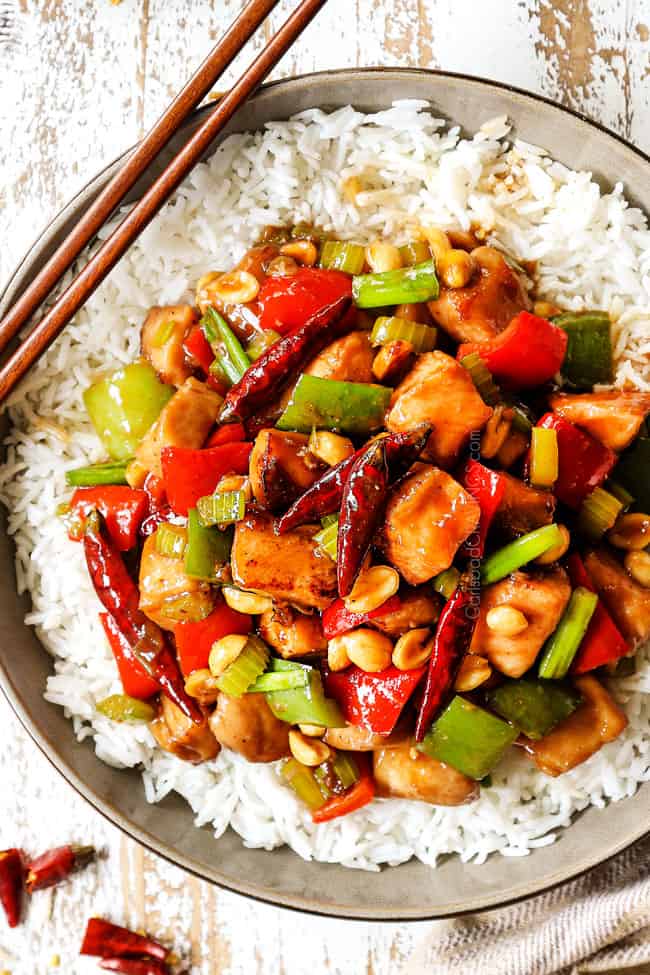
Want to try this Kung Pao Chicken RECIPE?
Pin it to your Dinner or Chicken Board to SAVE for later!
Find me on Pinterest for more great recipes! I am always pinning :)!
©Carlsbad Cravings by CarlsbadCravings.com

Kung Pao Chicken
Save This Recipe To Your Recipe Box
You can now create an account on our site and save your favorite recipes all in one place!
Ingredients
CHICKEN MARINADE
- 1 1/2 pounds chicken breasts chopped into 1 1/2″ pieces
- 2 tablespoons reduced sodium soy sauce
- 2 tablespoons cornstarch
- 1 tablespoon rice wine or dry sherry see notes in post
- 1 teaspoon toasted sesame oil
- 1 teaspoon baking soda
SAUCE
- 1/3 cup reduced sodium chicken broth
- 3 tablespoons oyster sauce
- 2 tablespoons reduced sodium soy sauce
- 1 tablespoon Chinkiang (Chinese black vinegar) may sub ½ TBS balsamic vinegar, ½ TBS rice vinegar
- 1 tablespoon rice wine
- 2 tablespoons brown sugar
- 1 teaspoon toasted sesame oil
- 1 1/2 teaspoons cornstarch
- 1 teaspoon ground Szechuan peppercorn (Szechuan powder)
STIR FRY
- peanut oil or vegetable oil
- 1/2 cup roasted, UNSALTED peanuts
- 4 green onions white parts thinly sliced; green parts sliced into 1-inch pieces
- 1 red bell pepper chopped into 1-inch pieces
- 1 green bell pepper chopped into 1-inch pieces
- 2 stalks celery halved lengthwise then thinly sliced
- 1 tablespoon minced ginger
- 3-4 cloves garlic minced
- 15 whole Thai dried red chilies *see Notes for substitutions
- seeds from 5-10 Thai dried red chilies *see Notes for substitutions
Instructions
- Add the velveting/marinade ingredients to a large freezer bag or bowl; whisk to combine. Add chicken and turn until evenly coated. Let sit at room temperature while you prep the rest of the ingredients; 15-30 minutes (no more). Meanwhile, whisk Sauce ingredients together in a medium bowl; set aside.
- Heat 1 tablespoon vegetable or peanut oil in a large nonstick skillet over medium-high heat. Once very hot, add chicken in a single layer and cook until golden then stir and cook chicken just until opaque. Transfer to a plate (chicken will not be cooked through).
- To the now empty skillet, heat 1 ½ tablespoons oil over medium-high heat. Once very hot, add peanuts, white parts of onions, celery, bell peppers, ginger, garlic, dried chilies and chili seeds and stir fry one minute.
- Serve with rice and garnish with green onions and sesame seeds if desired.
Notes
WHAT CHILI PEPPERS SHOULD I USE?
- You want DRIED, Thai chilies. Thai chilies typically can be found at an Asian market or on Amazon. Dried Thai chilies are one-half to two inches long. These chilies range from 50,000 to 100,000 Scoville heat units which is 23 times the average heat of a jalapeño!
- In order to not burn our mouths off, we stir fry the chilies whole and only add some seeds to taste. This is akin to using the flesh of the jalapenos without the seeds – you still get the flavor and some of the heat but not the numbing heat.
- *You do not eat the dried chilies. They release heat as they cook and are left in the finished dish for garnish.
HOW TO CUSTOMIZE SPICE LEVEL USING CHILIES
Kung Pao Chicken is meant to have a kick from chilies, ginger and garlic. That being said, it is very EASY to customize the heat of this recipe.- MILD KUNG PAO CHICKEN: Stir fry 15 Thai chili peppers without cuttings any of them open (and of course, don’t eat the whole chilies!). This will produce mild Kung Pao Chicken that will probably be too mild and taste like it’s missing something – which is heat! You can add heat by adding chili sauce, red pepper flakes or seeds from some of the chilies.
- MODERATE KUNG PAO CHICKEN: Stir fry 15 Thai chili peppers without cuttings any of them open and seeds from 5 additional chilies, or more to taste. To add the seeds, simply cut the dried chilies open and shake the seeds out. You can also add additional seeds after you’ve tasted the finished dish if it’s not spicy enough or add seeds to individual servings.
- SPICY KUNG PAO CHICKEN: Stir fry the Kung Pao Chicken with the 15 whole Thai chilies but instead of adding seeds from 5 chilies, add more to taste. I would say 10 chilies adds a nice kick of heat but is not crazy spicy. For super spicy, use seeds from more than 10 chilies. Of course, you can always start with less and add more to taste.
THAI CHILIES SUBSTITUTE
- If you can’t locate Thai chiles, you can substitute them with Asian chili sauce (such as sambal oelek) which is made from a combination of chilies, including Thai chilies.
- I recommend 1 tablespoon Asian chili paste plus ½ teaspoon red pepper flakes for medium spicy and 2 tablespoons Asian chili paste plus ½ teaspoon for spicier. Always start with less heat and add more to taste – because you can add heat but it’s hard to take away!
- If you know you don’t like very spicy food, then I would only use 1 tablespoon Asian chili sauce and eliminate the crushed red pepper flakes. From there, you can add back a small pinch of red pepper flakes or Asian chili sauce to taste to the entire Kung Pao Chicken or to your individual servings.
TIPS AND TRICKS
This Kung Pao Chicken recipe is pretty straightforward, but here are some tips and tricks to make it a sizzling success:- Don’t use salted peanuts. Only use UNSALTED peanuts or your Kung Pao chicken will be far too salty. Also, purchase roasted, unsalted peanuts for an added dimension of flavor, otherwise, toast the peanuts yourself in a dry skillet over medium heat until golden in some pots.
- Szechuan peppercorn: You will need 1 teaspoon ground Szechuan peppercorn. You can purchase whole ones and toast and grind them yourself, although I find it easier to just purchase ground Szechuan powder. Szechuan peppercorn can be found on Amazon (my fav!) at most Asian markets (call first) spice stores, or sometimes specialty stores like Whole Foods and Sprouts.
- Use QUALITY oyster sauce like Lee Kum Kee or Kikkoman because you literally can TASTE the difference!
- Chop chicken into large pieces. Go for about 1 ½ inch pieces of chicken. Larger pieces of chicken are harder to overcook and dry out and will taste far juicier.
- Customize veggies. You can substitute the bell peppers for your favorite veggies. Cut long cooking vegetables small and short cooking vegetables larger.
- Don’t skip the marinade/velveting. This ensures that the chicken is tender just like Chinese restaurants. If you need to skip it, then go with chicken thighs instead of chicken breasts.
- Don’t marinate chicken for too long. The bite-size pieces of chicken should not be marinated longer than 30 minutes or else they can become mushy.
- Don’t overcook chicken. For the juiciest chicken, don’t overcook! Brown it in the skillet but let it finish cooking in the sauce.
- Don’t overcook bell peppers. I suggest setting the timer for 60 seconds so you don’t overcook the bell peppers. It is better to under-cook them when stir frying then allow them to reach desired-crisp tenderness once you add the sauce.
- Add sauce to the sides of the pan. Pour the sauce around and down the sides of the pan instead of directly into the center. This will prevent the pan from cooling down too much.
HOW TO PREP AHEAD
Kung Pao Chicken has a few steps, but you can prep almost everything ahead of time for a speedy dinner. Here’s how:- Chop chicken. Chop chicken into large bite size pieces any time before marinating then store in an airtight container in the refrigerator.
- Make sauce. Whisk the ingredients together up to 24 hours in advance and store, covered in the refrigerator. Let the sauce sit at room temperature for 30 minutes or so before using.
- Chop veggies. You can chop your garlic, grate your ginger and chop your celery and bell peppers 24 hours in advance and store in separate air tight containers in the refrigerator.
- Cook! Within the next 24 hours, proceed with the recipe starting with marinating the chicken for 20-30 minutes.
HOW TO STORE and REHEAT
Kung Pao Chicken reheats very well if not initially overcooked.- How to store: Store leftovers in an airtight container in the refrigerator for up to 5 days.
- How to reheat in microwave: Transfer small portions to a microwave safe dish, heat for one minute, stir then continue to heat at 30 second intervals.
- How to reheat on the stove: For larger portions, rewarm gently in a large skillet, stirring often. You may need to add a splash of water (better yet chicken broth if you have it) to thin the sauce as needed.

Did You Make This Recipe?
Tag @CarlsbadCravings and Use #CarlsbadCravngs
Leave a Review, I Always Love Hearing From You!
Carlsbad Cravings© Original
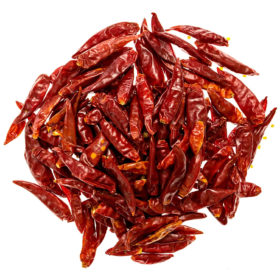
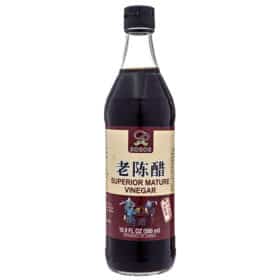
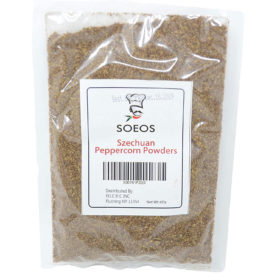
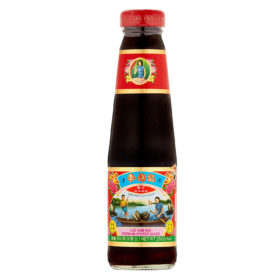

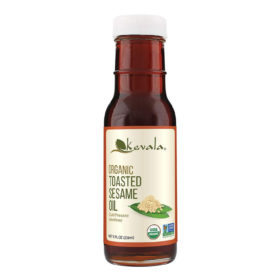
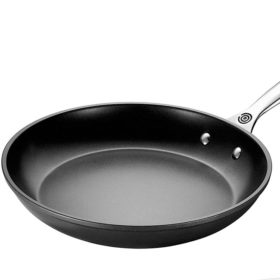
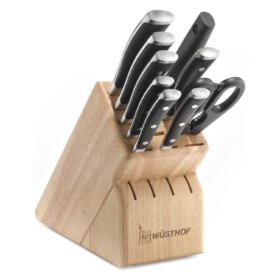

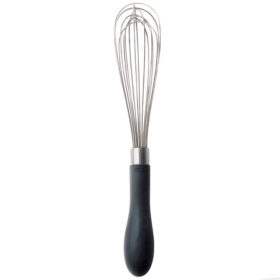

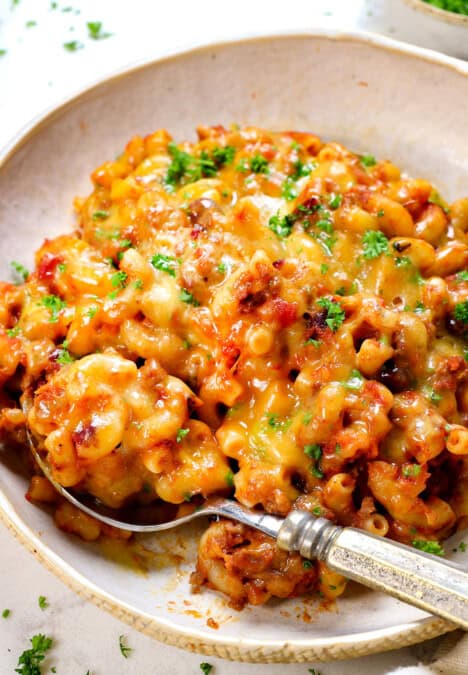
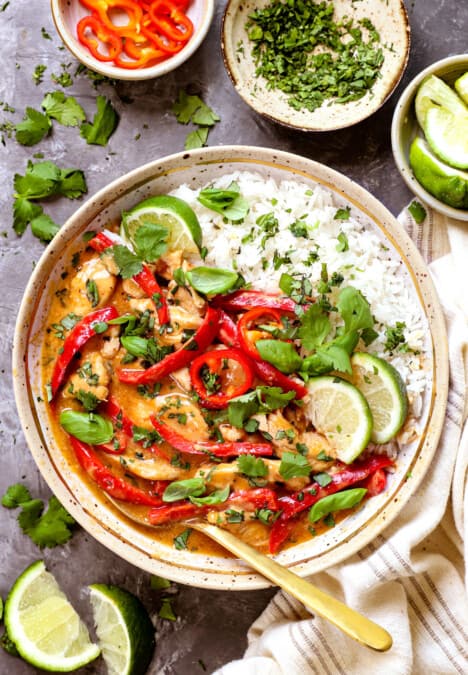

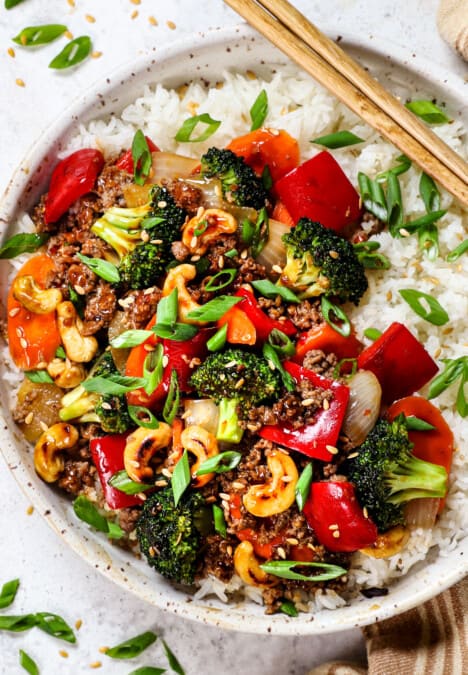

























Jen says
Thank you for your awesome review Teri! I’m thrilled you loved this recipe so much and found the chicken so tender!
I'manee says
The sauce was absolutely perfect! And I cannot ever make any type of stir fry without using the velveting technique which I learned from your chicken stir fry recipe! It seriously tastes better than take out – and I know exactly what I’m putting into my body!
Love this recipe!
Jen says
It doesn’t get better than “perfect” so thank you so much I’manee! I love that you’re a fan of velveting as well – such a game changer!
Carol says
This was excellent! I made it for guests and they were impressed with homemade Chinese and how pretty it looked. I made it moderate heat but will do spicy when making it just for me.
Jen says
Thanks Carol, I’m so pleased it was a hit with everyone!